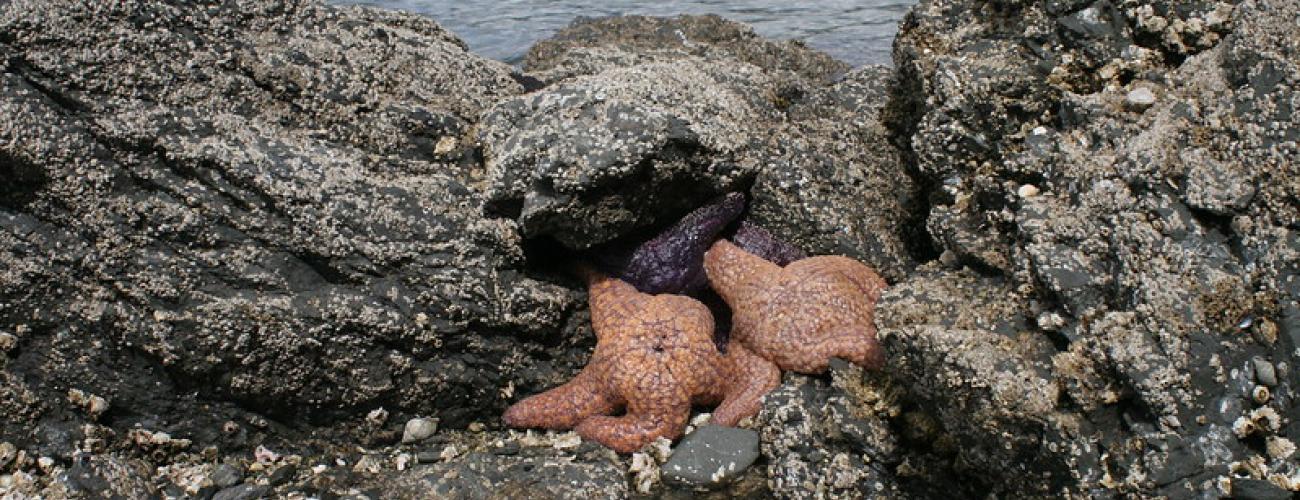Obstruction Pass State Park History
Obstruction Pass State Park allows visitors to experience the vibrant rocky shoreline of the San Juan Archipelago next to a tight marine passage that features strong tidal currents. The park is perched on an appendage of Orcas Island that is separated from nearby Blakely Island by a narrow channel that is nearly filled with an “obstructing” small island. The rush of waters channeled through the 350-foot-wide passage can exceed six knots (about seven miles per hour) at tide changes.
A Rocky Headland in the San Juan Archipelago
The San Juan Islands are distinct from most of Puget Sound in that they feature shorelines with exposures of hard bedrock, rather than the bluffs of clay, sand and gravel left by Ice Age glaciers that are predominant on most of Washington’s Salish Sea.
The specific rocks that are seen in the outcrops at Obstruction Pass State Park are a turbidite, a type of rock formed by petrification of a deposit formed by undersea flows of saturated submarine sediments, usually under the influence of gravity on a slope.
Indigenous Land
The park lies within the traditional territory of Coast Salish language speaking Indigenous people whose present-day descendants include members of the Lummi Nation, Samish Indian Nation, Swinomish Indian Tribal Community, and First Nations in Canada.
For thousands of years the lands and waters of the San Juan Archipelago have provided habitat for a diverse community of life that forms the basis of their cultures. As winter days lengthen into spring, herring and herring roe collect in the eelgrass beds near shore. A little later, spring Chinook salmon pass through the island channels. Early summer brings sockeye salmon, harvested for millennia with reef nets. Sea urchins are gathered by expert divers in late summer, and clamming peaks in the fall.
In the 1700’s many nations attempted to discover and claim a “Northwest Passage” connecting the Atlantic and Pacific Oceans. The Spanish Crown claimed exclusive rights to colonize the west coast of North America based on the 1494 Treaty of Tordesillas. Eight expeditions between 1774 and 1790 charted parts of today’s Pacific Northwest coast and established a Spanish settlement at Nootka Sound on Vancouver Island. In 1791, Spanish Naval Officer Francisco de Eliza y Reventa was sent to reinforce the Spanish presence at Nootka Sound and direct further exploration of the Strait of Juan de Fuca as a possible Northwest Passage. During June of that year, Eliza’s pilots charted much of the San Juan Archipelago, and the name “Orcas” was ultimately applied to the largest island in the group to honor Juan Vicente de Guemes Pacheco de Padilla y Horcasitas, Second Count of Revillagigedo and the Viceroy of Mexico from 1789 to 1794.
Spain claimed the area as part of its Territorio de Nutka but relinquished the claim to the United States in the 1819 Adams-Onis Treaty, later confirmed by newly independent Mexico. Dual claims to the region by the US and Britain were negotiated in 1846, but the status of the San Juan Archipelago remained disputed until the competing claims were adjudicated by a commission appointed by German Kaiser Wilhelm I in 1872.
Local tribes had ceded ownership of the area to the US federal government under duress in the Treaty of Point Elliot in 1855, in spite of the as-yet unsettled colonial administration of the San Juan Archipelago. The tribes reserved rights to harvest natural resources in their usual and accustomed places, including the lands and waters surrounding Orcas Island.
Statehood Grant
The section 16 that includes today’s Obstruction Pass State Park is a partial section, due to the island shoreline, and contains only 420 acres instead of the full 640 acres in a surveyed section. Because the land was more difficult to manage for income to trust beneficiaries, parcels of the section were sold at state land auctions in 1916, 1920, 1922 and 1941 to provide income for trust beneficiaries. The remaining 80 acres were difficult to access and were not logged or developed.
Making a Park
The Washington Department of Natural Resources developed a primitive recreation site on the property after a road access easement was obtained from adjoining landowners in 1971 with funding from the Washington Interagency Committee for Outdoor Recreation (now the Recreation and Conservation Office [RCO]).
In 1989, the Washington State Legislature authorized the Trust Land Transfer Program. The legislature funds the transfer of state trust lands with special ecological or social values that have low income potential out of state trust ownership to a public agency that can manage the property for those values. Money from the transfer provides revenue for the trust beneficiaries and is used to buy productive replacement properties that will generate future trust income.
In 2002, the legislature appropriated $5.7 million to fund a 50-year lease of the property to the Washington State Parks and Recreation Commission (WSPRC), which provides management of the site with staff from nearby Moran State Park.
In 2019, the RCO awarded the WSPRC a grant of $1.9 million to purchase 56 acres next to Obstruction Pass State Park to allow expansion of the park’s trail system and provide public access to the shoreline at Spring Bay, a small pocket beach by the shore of Obstruction Pass. The parcels were originally sold to private buyers at state land auctions in 1920 and 1922 for a total of $937.50.
Sharing the histories of Washington’s state parks is an ongoing project. Learn more here.

